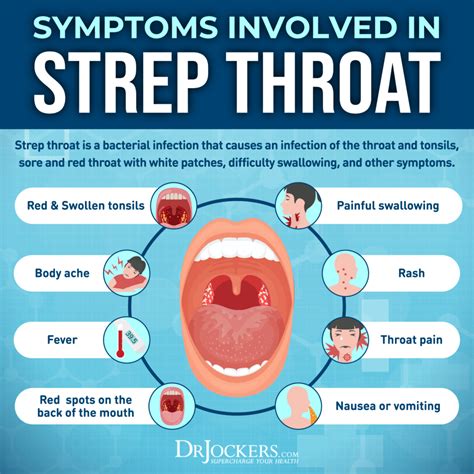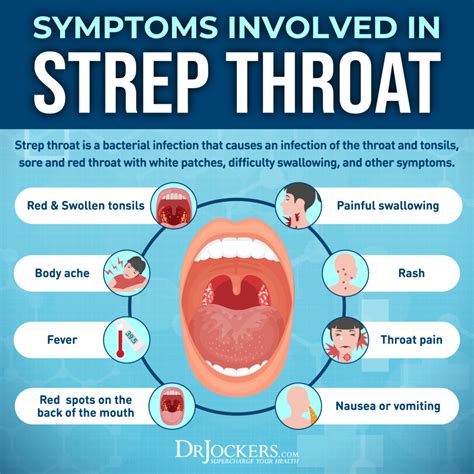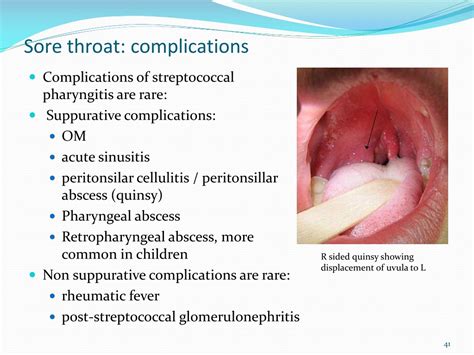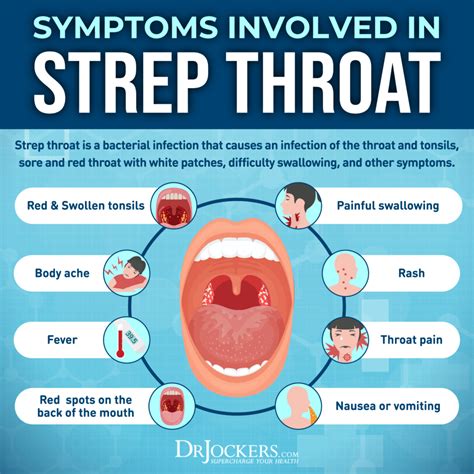Intro
Identify strep throat symptoms with 5 key signs, including sore throat, fever, and swollen tonsils, to determine if you need antibiotic treatment for this bacterial infection, and learn about its causes, diagnosis, and recovery process.
Strep throat, also known as streptococcal pharyngitis, is a common and highly contagious infection that affects the throat and tonsils. It is caused by the Group A Streptococcus bacteria and can spread through close contact with an infected person, usually through respiratory droplets or by touching contaminated surfaces. Recognizing the signs and symptoms of strep throat is crucial for seeking timely medical attention and preventing potential complications.
The importance of identifying strep throat early lies in its potential to lead to more severe conditions if left untreated. Complications can include kidney inflammation, rheumatic fever, and abscesses in the throat. Moreover, strep throat can significantly impact daily life, causing discomfort, pain, and difficulty swallowing, which can lead to dehydration and nutritional deficiencies, especially in children and the elderly.
Understanding the signs and symptoms of strep throat can help individuals take proactive steps towards recovery and prevention. This includes being aware of the common signs, knowing when to seek medical help, and understanding the treatment options available. By recognizing the early signs of strep throat, individuals can seek medical attention promptly, reducing the risk of complications and ensuring a faster recovery.
Introduction to Strep Throat

Causes and Risk Factors
The primary cause of strep throat is the Group A Streptococcus bacterium. This bacterium is highly contagious and can be spread through direct contact with an infected person's saliva, mucus, or other bodily fluids. The risk factors for developing strep throat include close living conditions, poor hygiene, and a weakened immune system. Children and young adults are more susceptible to strep throat due to their frequent exposure to other children in school settings.Signs and Symptoms of Strep Throat

Treatment Options for Strep Throat
The treatment for strep throat usually involves a course of antibiotics to eliminate the bacterial infection. It is essential to complete the full course of antibiotics as prescribed by the healthcare provider, even if symptoms improve before finishing the medication. In addition to antibiotics, over-the-counter pain relievers and throat lozenges can help alleviate symptoms and reduce discomfort.5 Common Signs of Strep Throat

Prevention and Management
Preventing the spread of strep throat involves practicing good hygiene, such as frequent handwashing, avoiding close contact with infected individuals, and covering the mouth and nose when coughing or sneezing. Managing strep throat includes staying hydrated, getting plenty of rest, and using a humidifier to relieve throat discomfort.Complications of Untreated Strep Throat

Seeking Medical Attention
It is essential to seek medical attention if symptoms of strep throat persist or worsen over time. A healthcare provider can perform a physical examination, review medical history, and conduct diagnostic tests to confirm the presence of the Group A Streptococcus bacteria.Diagnosis and Testing

Treatment and Recovery
The treatment for strep throat usually involves a course of antibiotics, which can help alleviate symptoms and prevent complications. It is essential to complete the full course of antibiotics as prescribed by the healthcare provider, even if symptoms improve before finishing the medication. Rest, hydration, and good nutrition are also crucial for recovery.Living with Strep Throat

Future Outlook
The future outlook for individuals with strep throat is generally positive, with most people making a full recovery within a week to 10 days. However, it is essential to seek medical attention if symptoms persist or worsen over time to prevent potential complications.Conclusion and Next Steps

We invite you to share your experiences with strep throat in the comments below. Have you or a loved one been diagnosed with strep throat? What were your symptoms, and how did you manage them? Your stories can help others understand the importance of recognizing the signs and symptoms of strep throat and seeking medical attention promptly.
What are the common symptoms of strep throat?
+The common symptoms of strep throat include a sore throat, fever, swollen lymph nodes, white patches on the tonsils, and loss of appetite.
How is strep throat diagnosed?
+Strep throat is typically diagnosed using a rapid strep test or a throat culture. A healthcare provider may also perform a physical examination and review medical history to confirm the diagnosis.
What are the complications of untreated strep throat?
+Untreated strep throat can lead to several complications, including rheumatic fever, kidney inflammation, and abscesses in the throat. These complications can cause significant harm and require prompt medical attention.
